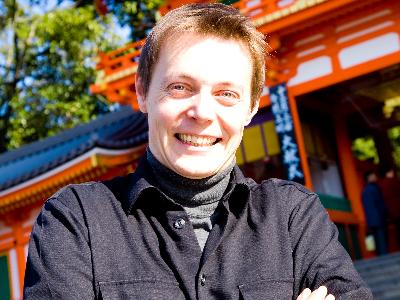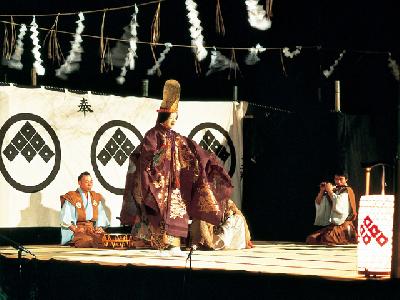|
Ondrej Hybl
Ondrej Hybl was born in 1977 in Czech Republic. He studied Kyogen Ookura style, the traditional Japanese theater, under the influence of Shigeyama Sengorou. In 2000, he started studying at Charles University Graduate School of Philosophy. In 2002, he enrolled in Doshisha University Graduate School of Letters as an exchange student. He began studying Kyogen under Kyogen Master, Shime Shigeyama.
After graduating with a master’s degree from Doshisha University in 2005, he further moved his study and is currently studying for his doctorate at Oosaka University Graduate School of Letters. At EXPO 2005, Mr. Hybl was recognized by the Czech Republic government for his work and contribution as a representative of Czech Republic.
Mr. Hybl, who became fascinated with the Kyogen world which is a quintessential traditional Japanese performing art, became the first Czech Kyogen pupil.
He says that Kyogen requires technique to make people laugh, but that the laughter is not cheap. It is a humor that is kind to people.
Mr Hybyl adds “When people laugh, the boundary between countries disappears. Now that Kyogen is recognized as a world heritage art form, Kyogen has become a valuable asset for people all over the world. Kyogen, which has deep roots in the ancient Japanese world, has the potential to make people in the world rich inside.”
Ondrej Hybl was born in 1977 in Czech Republic. He studied Kyogen Ookura style, the traditional Japanese theater, under the influence of Shigeyama Sengorou. In 2000, he started studying at Charles University Graduate School of Philosophy. In 2002, he enrolled in Doshisha University Graduate School of Letters as an exchange student. He began studying Kyogen under Kyogen Master, Shime Shigeyama.
After graduating with a master’s degree from Doshisha University in 2005, he further moved his study and is currently studying for his doctorate at Oosaka University Graduate School of Letters. At EXPO 2005, Mr. Hybl was recognized by the Czech Republic government for his work and contribution as a representative of Czech Republic.
Mr. Hybl, who became fascinated with the Kyogen world which is a quintessential traditional Japanese performing art, became the first Czech Kyogen pupil.
He says that Kyogen requires technique to make people laugh, but that the laughter is not cheap. It is a humor that is kind to people.
Mr Hybyl adds “When people laugh, the boundary between countries disappears. Now that Kyogen is recognized as a world heritage art form, Kyogen has become a valuable asset for people all over the world. Kyogen, which has deep roots in the ancient Japanese world, has the potential to make people in the world rich inside.”
| [→より詳しい記事を見たい方はこちら] | |
| [+ADDRESS] | 
|















